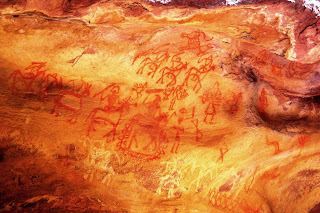Monday, March 30, 2015
Tuesday, September 29, 2009
Bhimbetka - The Altamira of India
Vishnu Wakankar discovered the Bhimbetka rock shelters in 1957. Those rock shelters dated back to Mesolithic and even to the late Palaeolithic (old stone age) period. The rock arts belong to the Mesolithic (middle stone age - circa 10,000 before present [BP]) period. I am not a historian and not an expert in rock art. So instead of daring to write too much, I am going to add the relevant links.

Wikipedia has a nice concise summary of the art and its history:
http://en.wikipedia.org/wiki/Bhimbetka
Thursday, December 11, 2008
The transition
Monday, November 17, 2008

I do not understand why some people hate squirrels. We have plenty of tiny squirrels in our garden. They are very timid and feed on fruits and termites. They clean themselves very often. They are playful and often hang around in pairs. Although I am no Gussie Fink Nottle (Wodehouse readers know what I am talking about), but I think they are fun to watch. Here is a little member from our garden.

Wednesday, March 7, 2007
Historic Saptagram-Tribeni

A scholarly, yet brief review on Saptagram can be found in :


"History has many cunning passages, contrived corridors
And issues, deceives with whispering ambitions,
Opposite to it flows the river Ganges. Here you see a tiny hand-made wooden boat used by a local fisherman. Some of the things did not change in the last thousand years.
and some obviously did...

Not too far from here, there are two beautiful temples. One is Hanseswari... Its unique architecture is unlike any other temple of Bengal. It does have some resemblance with St Peters Chapel of Moscow. Recently the temple underwent minor renovation. White paints were used in several parts of the temple. I like the original uncoloured red bricks rather the coloured structure. Renovation and restoration are two different words to me, and I prefer the later when it comes to old structures.
The other one is the Basudeb temple. It is a single canopied Bengal-style architecture.
The burnt-clay terracotta on the walls of the Basudeb-temple are slightly worn out with its age. A few of them have been removed (not sure by whom). Still, you can see quite a few of them. They depict stories from the Hindu mythologies. I wish I had better pictures of the terracotta than these:
As a young boy, I used to bike on the road along the riverbank. On some hot summer afternoons I would sit underneath the shade of an old tree and refresh myself with the river breeze, and hear the boatmen singing folklores from their tiny fishing boats. I wondered a thousand years ago, I would probably watch the Roman or the Portuguese or the Sumatran sailors singing some unknown melodies, perhaps the folklores from their own land. I would not understand the lyrics, but I know that they would be songs of love, or of amorous grieves and pangs. After all we are all the same...our melodies might vary, but not our feelings.
Wednesday, January 10, 2007
Here is a rice field. You could see goats and cows grazing there. The field close to you has already been harvested. The ones farther are ready to be reaped.

You can see some cows from close.

India is a country of peaceful coexistence and tolerance. One interesting thing about Indian roads is that both drivers and animals share them thinking that they have priority over the other. Here is an example:
 As you see, a hen is right in the middle of the road. If you use a magnifying-glass you can see a few more further away. The dog, being an intelligent animal, stayed off the road and is possibly thinking when he would get a chance to sleep on the clean road. The goats (below) are busy in their altruistic duty to prune any grass growing right next to the road.
As you see, a hen is right in the middle of the road. If you use a magnifying-glass you can see a few more further away. The dog, being an intelligent animal, stayed off the road and is possibly thinking when he would get a chance to sleep on the clean road. The goats (below) are busy in their altruistic duty to prune any grass growing right next to the road.
Would you agree any less that Indians live in a very symbiotic society, where animals and men (and women, to be politically correct) share their social responsibilities, and make this earth a better place for each other?
With this I conclude this part of the blog. Any comment, question or suggestion will be greatly appreciated.














